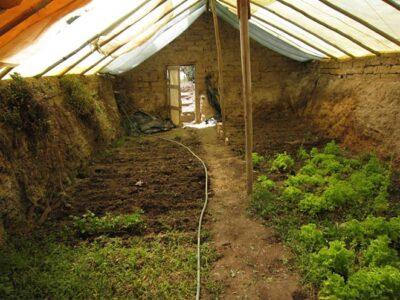
Image source: Treehugger.com
As more people become aware of the importance of growing their own food, social media has become a primary way ideas are shared. One of these ideas which is often seen on Facebook and Pinterest is the walipini underground greenhouse.
This greenhouse claims to grow food year-round and only cost $300 in building materials. For lots of gardeners, particularly those in cool climates with short growing seasons, a greenhouse is almost a must-have. Let’s take a look at the advantages of an underground greenhouse:
Takes advantage of thermal mass. When you dig down even just four feet, the temperature changes dramatically. Frost lines generally are three to four deep, so a six to eight foot walipini is completely protected from frost. One walipini owner claims that his greenhouse keeps pretty steady 70 degree Fahrenheit or warmer temperatures when it’s 10 degrees outside. Because underground greenhouses are warmed by thermal mass on all sides, you really can’t lose any warmth compared to a traditional greenhouse.
Effective in almost any climate. Walipini and other pit-style greenhouses are effective nearly everywhere. In fact, many of the early designs for these greenhouses originated in very cold climates like Canada. Of course, you won’t be able to get super-hot temps in a cold climate in winter, but it will get warmer than a traditional greenhouse. Many countries outside of the United States swear by these designs, particularly gardeners in China.
More visually appealing – and hidden. While this is a matter of opinion, most people do agree that underground greenhouses are far more appealing because they don’t take up as much visual space on their landscape.
Get Delicious, Nutrient-Dense Heirloom Seeds Here!
Walipinis built into a natural slope are difficult to notice at all from a distance. Aside from the outside perspective, many people prefer the very natural look of the inside of an underground greenhouse.
Story continues below video
Versatile in its use. Obviously, the purpose of a greenhouse is to grow produce, but underground greenhouses are also an alternative way of keeping (at least some) livestock. Some people might build a very large walipini with room for goats, sheep or chickens. Others might dedicate a whole building just for livestock. In winter this can be especially beneficial for cold-sensitive livestock. Walipinis really have the same advantages of an underground home.
Doesn’t require much maintenance. Traditional greenhouses are completely exposed to the elements, which means the building material gets worn down more quickly. The only exposed area on a walipini is the roof and perhaps some beams within the structure. Garden beds are completely protected from rain, so they will last much longer.
New Natural Fertilizer Doubles Garden Production!
Many owners also find that their watering and weeding time is cut in half. Weed seeds will have a more difficult time getting into your plants from outdoors, plus the dirt you’re using is completely virgin. Walipinis tend to hold humidity and soil moisture well, so watering generally doesn’t have to happen as often.
Protection from chemicals and pests. A HUGE advantage of underground greenhouses is the fact that it is nearly impossible for most chemicals and pests to get on your produce. If you live in an area that sprays pesticides, you won’t have to worry about wind carrying them to your plants. Similarly, pests like insects would only be able to enter through the open door of the greenhouse or on your clothes. Deer and rabbits obviously wouldn’t have access, and neither would domestic pests like cats, who like to use gardens as litterboxes.
If you have easy access to earth-moving equipment or a group of people who are interested in helping you dig, underground greenhouses are definitely a viable option in most circumstances. While they differ quite a bit from traditional greenhouses, their effectiveness isn’t inhibited.
For more information on the walipini $300 greenhouse, check out this link. Here is another person’s take on walipini greenhouses with some very interesting “hacks” to improve the design.
Do you have any underground greenhouse tips? Share them in the section below: